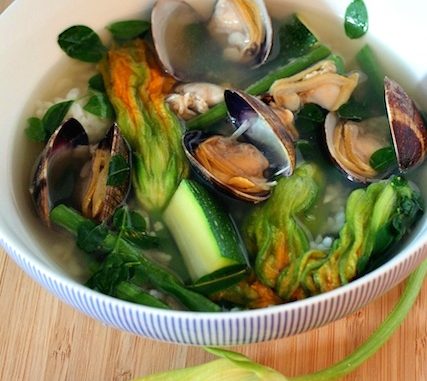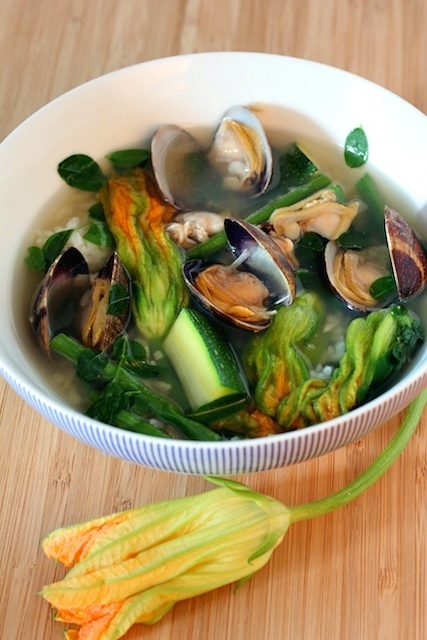
Dinengdeng is a hearty vegetable soup from the Ilocos region of the Northern Philippines. Though simple in ingredients and preparation, this soup with a funny name can be a very complex and flavorful dish. With a broth seasoned with Bagoong (fermented fish or shrimp paste) and/or Patis (fish sauce), the Ilocano soup can feature a variety of vegetables including long beans, squash, squash flowers, okra, bittermelon, and fresh malunggay leaves—really whatever fresh native Filipino vegetables are available to the cook.
Dinengdeng is also often fortified with leftover fish from a previous meal—a culinary signifier of our Filipino frugality and not wanting to waste one bit of food. Depending on the preparation of the leftovers, a different depth of flavor is added to the soup—i.e. grilled or broiled fish lends smokiness to the dish, while fried fish lends fattiness. Leftovers, though, are not a hard and fast rule when it comes to Dinengdeng; feel free to use fresh seafood as you like.
For this version of Dinengdeng, we’ve used live Manila clams and just enough white wine to help steam the bivalves open to spill their brine into the soup base. As for vegetables, we’ve used fresh long beans, as well as zucchini and zucchini blossoms from my mother’s garden. And at the very last moment before eating, stirred some fresh malunggay leaves into the pot.
Dinengdeng: Vegetable Soup & Clams Recipe
Ingredients:
- 1 tablespoon vegetable oil
- 1 small shallot, minced
- 2-3 garlic cloves, minced
- 1-inch piece of ginger, minced
- 2.5 lbs. fresh, live Manila clams, rinsed clean
- 1/4 cup white wine
- 5 cups water
- About 10 long beans, cut into 2-inch lengths
- 2 zucchinis, cut lengthwise into wedges
- 1-2 tablespoons fish sauce, plus more to taste
- 10-12 fresh zucchini blossoms
- 1 cup packed fresh malunggay leaves
Cooking Instructions:
- Heat the oil in a medium soup pot or saucier over medium-high heat.
- Add the shallots, garlic, and ginger and cook until shallots soften, and garlic just begins to brown, 3-5 minutes.
- Add the clams to the pot, along with the white wine, reduce heat to medium low, and cover pot.
- Continue cooking until clams open. Using tongs, transfer opened clams to a large bowl, making sure to leave the clam juices in the pot. Discard any clams that do not open after 5-7 minutes of cooking.
- Add the water to the pot and bring to a boil over high heat. Add the longbeans, reduce heat to low, and simmer for 3 minutes.
- Add the zucchini to the pot and continue simmering until the beans and zucchini are tender, 3-4 minutes more.
- As the soup simmers, you can choose to remove the clams from their shells.
- Add the fish sauce and taste the soup. Season with more fish sauce as desired.
- Add the squash blossoms to the soup and simmer for 1-2 minutes until the stems of the blossoms are tender.
- Remove the pot from the heat, then add the reserved clams. Stir in the malunggay leaves and serve immediately with rice. (Source: burntlumpiablog.com)

Looking for other Lutong Bahay Recipes to try on? Feel free to check out our ulam recipes, desserts recipes and snacks recipes.
Some visual and written contents are copyrighted to their respective and considerate owners. We do not claim that these recipes or photos are proprietary to us. If this is yours and you would like it to be removed and not shared with others, please let us know by sending an email to contact @ lutongbahayrecipe.com, you may use our website contact form or by sending a message on our Facebook page. Read our disclaimer.

Leave a Reply